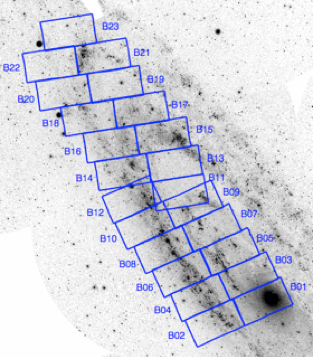Mission Overview
The Panchromatic Hubble Andromeda Treasury (PHAT)
Primary Investigator: Julianne Dalcanton
HLSP Authors: Benjamin Williams, Meredith Durbin, Dustin Lang, Julianne Dalcanton, Andrew Dolphin, Adam Smercina, Petia Yanchulova Merica-Jones, Daniel R. Weisz, Eric F. Bell, Karoline M. Gilbert, Leo Girardi, Karl Gordon, Puragra Guhathakurta, L. Clifton Johnson, Tod R. Lauer, Anil Seth, Evan Skillman
Released: 01-01-2012
Updated: 08-11-2023
Primary Reference(s): Dalcanton et al. 2012, Williams et al. 2014, Williams et al. 2023
DOI: 10.17909/T91S30
Citations: See ADS metrics
Source Data:
- See Data Access Table below for HST proposal IDs
Slideshow
Overview
The Panchromatic Hubble Andromeda Treasury is a Hubble Space Telescope Multi-cycle program to map roughly a third of M31's star forming disk, using 6 filters covering from the ultraviolet through the near infrared. With HST's resolution and sensitivity, the disk of M31 will be resolved into more than 100 million stars, enabling a wide range of scientific endeavors.
The PHAT observations are grouped into 23 "bricks", each listed under a different proposal ID. Each brick consists of a 3x6 array of pointings, producing complete coverage in the UV, optical, and NIR. Each brick is observed as two 3x3 "half bricks", with observations taken ~6 months apart. In the first observing season, a 3x3 half brick of WFC3 pointings is completed in primary, while parallel observations produce a highly overlapping 3x3 tile of ACS observations in the adjacent half brick. After 6 months, the telescope can be rotated by 180 degrees from the original orientation, such that the primary WFC3 pointings cover the area that was tiled by ACS in the first season, and vice versa. Each pointing is observed for 2 orbits, using the 2 WFC3 cameras for one orbit each.
Filters: F275W+F336W (WFC3/UVIS), F475W+F814W (ACS/WFC), F110W+F160W (WFC3/IR)
Depth: UVIS data reach a magnitude limit of ~25 in F275W and F336W. ACS data reach maximum depths of ~28 magnitudes in F475W and ~27 magnitudes in F814W in the uncrowded outer disk. In these same regions, WFC3/IR data reach maximum depths of ~26.5 and ~25.5 in F110W and F160W, respectively. However, the depth is crowding limited in the optical and NIR, and thus is a strong function of radius. As a result, photometry in the inner bulge fields is far shallower.
Version 2
In November 2014, the PHAT team delivered version 2 photometry files.
Version 3
The team reprocessed all of the Hubble Space Telescope (HST) Wide Field Camera 3 (WFC3) and Advanced Camera for Surveys (ACS) near ultraviolet (F275W, F336W), optical (F475W, F814W), and near infrared (F110W, F160W) imaging from the PHAT survey using an improved method that optimized the survey depth and chip gap coverage by including all overlapping exposures in all bands in the photometry. An additional improvement was gained through the use of charge transfer efficiency (CTE) corrected input images, which provide more complete star finding as well as more reliable photometry for the NUV bands, which had no CTE correction in the previous version of the PHAT photometry. While this method requires significantly more computing resources and time than earlier versions where the photometry was performed on individual pointings, it results in smaller systematic instrumental completeness variations as demonstrated by cleaner maps in stellar density, and it results in optimal constraints on stellar fluxes in all bands from the survey data.
Data Products
Data file naming convention:
hlsp_phat_hst_<inst>_<pid>-m31-b<brick>-f<field>_<filter>_<version>_<exten>
where:
- <inst> is the instrument, one of "wfc3-uvis", "acs-wfc" or "wfc3-ir".
- <pid> is the HST proposal ID number
- <brick> is the brick number, e.g., "b01" for Brick 1.
- <field> is the field number, e.g., "f01" for Field 1. Files without field designation contain information for the complete brick (aka all fields).
- <filter> is the filter used.
- <version> is the version number, one of 1, 2 or 3.
- <exten> is the file extension. See table below for options.
Data file types:
| _drz.fits | Astronomically-correct drizzled images used for alignment and bookkeeping of star positions by DOLPHOT. |
|
_phot.fits(.gz) |
Six-band photometry output from DOLPHOT converted into binary fits format. |
|
_phot-all.txt.gz |
Same as above, including all measurements in the individual exposures (only for v3). |
| _columns.txt | Column descriptions for the phot-all.txt.gz files. |
| _st.fits | Star catalog file. |
| _gst.fits | Good star catalog file. |
| _rgb.jpg | Color jpg image of the field in that camera. |
| _dol.param | DOLPHOT parameter files |
Data Access
Catalog files can be retrieved from the table below. Each link will download a cURL script which will retrieve all related files for a given Brick and for a given version of the processing (see Data Products table for explanations of file types). Note that the download size can be large! The "_phot.fits" catalogs comprise ~5 GB per brick, and include flags for "st" and "gst" cuts instead of providing individual files; the "_phot-all.txt.gz" catalogs ("v3 (all)", same as _phot.fits, but including all individual exposures) comprise ~10 GB per brick; the "_st.fits" catalogs are ~2 GB per brick and the "_gst.fits" catalogs are ~1 GB per brick.
The full merged catalog of the v3 photometry (_phot.fits) can be downloaded directly here (warning: 99GB): Full Catalog
Image files can be retrieved from the table below. Each link will download a cURL script which will retrieve all related files for a given Brick (see Data Products table for explanations of file types). Note that the download size can be large! The "_drz.fits" images comprise ~10-100 GB per brick. The individual files can be accessed here.


